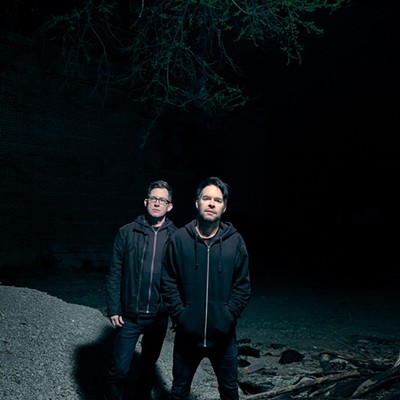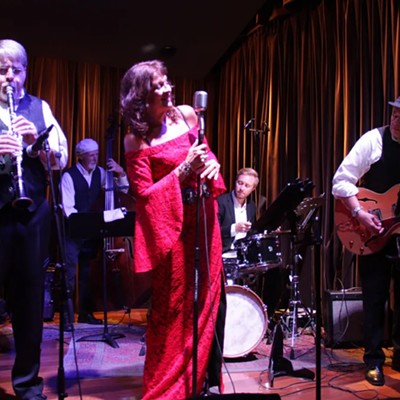Put it in a viola case.
It's jokes like these about the viola that perpetuate the instrument's not-so-popular reputation. The viola is lower-pitched than a violin and higher than a cello; in a symphony orchestra, the violists are the ones sitting in the middle, playing something slightly different than what the violins and cellos are playing. They're the black sheep of the orchestra--but without their melodic enhancements, certain things just wouldn't sound right.
And to add insult to injury, in rock bands, if there's a string instrument, chances are it's a violin or a cello. Portland, Ore.'s Talkdemonic defies many norms, but most intriguing is the fact that the primary instruments are drums and viola--drums being another instrument that's often made fun of. (What do you call someone who hangs out with musicians? A drummer.)
"That's the reputation (violists) have--'Oh, you're an insider instrument; you fill out the sound; you're midtoned to flesh out the general theme,' and I'm saying, 'No, that's not what we have to be; we can be whatever we want,'" said violist Lisa Molinaro. "You can do whatever you want with your instrument. I'm trying to hold true to the techniques that I've always learned, that I think are proper with a stringed instrument, but also constantly looking for ways to explore sounds, maybe get different sounds out of it."
Talkdemonic is a combination of Kevin O'Connor's experiments with beats and sounds and Molinaro's expansion of the viola's range. Often called "electroacoustic" or "organic," their music is instrumental, but voiced by layers of rhythm and melody. Banjo and piano blend with analog synth sounds and rhythms; in every Talkdemonic song, there is a audible tension between sound made from vibrations and sounds made from circuits firing. The result is music that sounds at home both in the Oregon forests and your friendly neighborhood trip-hop dance club.
Originally, Talkdemonic began as a beat project, explained O'Connor, but "right away, it morphed into something else, as we were including more and more strings." The inclusion of strings began after Molinaro saw O'Connor accompanying another Portland musician on drums and was impressed.
"I hadn't really seen anyone play drums the way he did--he had a lot of style, a lot of confidence, and I was looking to find people to play with in Portland when I first moved there, so I just walked right up to him and asked him if he'd be interested in playing some music," she said. "I hadn't really heard music like what he was putting together. I came from a classical background, and I heard a lot of rich melody in his music, and I liked that. Also, his drumming was the focus of the music. It was going against certain genre norms."
From there, Molinaro began adding her viola to O'Connor's songs, a process which O'Connor says helps to complete the loops and ideas he's put to tape.
"Usually, I start with a guitar loop or a keyboard loop or an idea or a beat," said O'Connor, "and then Lisa comes in and really makes it make sense."
Beat Romantic, the duo's second album, released last year, begins with viola chords that blend into a folk-style melody on the very short "Veraison," a term that signifies the change from the growth stage to the ripening stage in grapes. Beat Romantic then begins to ripen lusciously and quickly; quiet guitar introduces "Mountaintops in Caves," and by the end, the microbeats have fleshed out into a full drum-kit rhythm. The banjo on "Dusty Fluorescent/Wooden Shelves" and "Junesong" starts giving the record a brighter tone, and then comes the more hip-hop-rhythm "Cascade Locks" and "Skyscraper." The slightly darker, more viola-focused "Bering" begins to fill out the record with deeper greens and purples, and "Sept With Smith" steps in with chiming guitar and harpsichord, with Molinaro's viola a faint echo in the background.
By the second half, tracks like "Manhattan '81" and "Human Till Born" are pulling in sounds and textures from everywhere to create constantly moving landscapes of acoustic and electric sounds. The songs change mid-song, sometimes dramatically, with a certain melody or rhythm staying consistent throughout. Talkdemonic falls on the more imaginative and dreamlike side of the experimental-instrumental-music realm--the songs are short, sweet and filled to the brim with harmonies. It's music that is thoughtful, but never overthought; careful, but always relaxed.
"The goal for Talkdemonic is to not really try," said O'Connor. "Just doing whatever feels right, not necessarily forcing anything ... just making honest music that reflects your life, yourself. I think that sort of aesthetic comes through."
And, as Molinaro and O'Connor can attest, it can come through via any instrument, in spite of all of the jokes.








